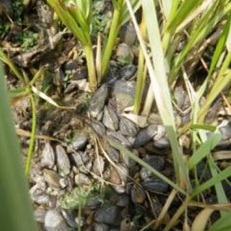Fauna
 The Bay and its tributaries supports more than 4,000 migratory and resident aquatic species. This includes more than 1,450 phytoplankton taxa, 225 zooplankton species, 800 species of invertebrates, 350 fish species, 100 species of reptiles and amphibians, and 6 marine mammal species (Wass et al. 1972; Marshall et al. 2005; Chesapeake Bay Program 2007; Murdy and Musick 2013). In addition there are about 140 species of waterbirds associated with Bay waters (Watts 2013). Sources describing the most commonly encountered Bay species include Lippson and Lippson (2006) and Funderburk et al. (1991).
The Bay and its tributaries supports more than 4,000 migratory and resident aquatic species. This includes more than 1,450 phytoplankton taxa, 225 zooplankton species, 800 species of invertebrates, 350 fish species, 100 species of reptiles and amphibians, and 6 marine mammal species (Wass et al. 1972; Marshall et al. 2005; Chesapeake Bay Program 2007; Murdy and Musick 2013). In addition there are about 140 species of waterbirds associated with Bay waters (Watts 2013). Sources describing the most commonly encountered Bay species include Lippson and Lippson (2006) and Funderburk et al. (1991).
Invertebrates found in the Bay include over 270 species of crustaceans (shrimp, amphipods, crabs), 120 molluscs, 100 polychaetes, and 70 cnidarians. About 170 of the invertebrates are classified as shellfish, aquatic invertebrates used as food.
Fishes can be broadly grouped as freshwater, estuarine, marine, anadromous, or catadromous. Most of the Bay fishes are seasonal visitors, with only about 32 resident estuarine fishes spending their entire lives in the Bay. There are 10 anadromous fish species, notably shads and herrings (alosine species), striped bass, and the endangered Atlantic sturgeon. Anadromous fishes live primarily in the sea, migrating to the freshwater reaches of Bay tributaries to spawn. During their first year, the Bay is used as a nursery ground. The single catadromous fish, American eel Anguilla rostrata, reverses this pattern living in the estuary for most of its life and migrating to spawn in the Sargasso Sea.
Marine reptiles include the seasonal sea turtle visitor loggerhead Caretta caretta that occupies the Bay as a nursery habitat. The only turtle that lives out its entire life in the estuary is the diamondback terrapin Malaclemys terrapin. The once hunted diamondback terrapin is now a regulated species of concern in Chesapeake Bay. Habitat loss and inadvertent mortality from blue crab pots are significant threats to the population.
Surprising to some, several species of marine mammals are common to Chesapeake Bay. The river otter Lontra canadensis is a year-round resident, Atlantic Bottlenose dolphin Tursiops truncates and whales are seen every year, the harbor seal Phoca vitulina is seen in the winter months, and the Florida manatee Trichechus manatus latirostris is an occasional visitor during the summer.
The number of Bay species will continue to change as endangered, threatened or sensitive species are lost and species ranges alter with a changing climate. For example, the salt marsh bird species black rail is in danger of elimination from Maryland and Virginia tidal marshes because of a loss of its essential habitat from rising seas (Watts 2016), whereas new collections of warmwater species (Trachinocephalus myops, snakefish; Citharichthys macrops, spotted whiff) in southern Chesapeake Bay have been substantiated, suggesting geographic range extensions for these species (Halvorson 2007).
CCRM Research
Much of our research is focused on understanding the influence that humans have on estuarine fauna – from individual species to communities of species occupying a common environment.

